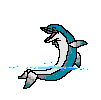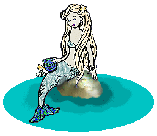|
Lessons >>> Lesson 28 |
Scuba diving is a wonderful summer outdoor activity adored by innumerable men and women across the globe. But like many outdoor activities, it is also inherently dangerous sport, which can only be performed in relative safety if you get proper training. Scuba Diving is not just a swim in the water; scuba requires certification and uses technical equipment. Scuba, which is actually an acronym for "self-contained breathing apparatus", allows divers to dive deeper and stays, submerged longer. Modern scuba diving gear consists of one or more gas tanks strapped to the divers back, connected to an air hose and an invention called the demand regulator. The demand regulator controls the flow of air, so that the air pressure within the diver's lungs equals the pressure of the water. The desire to go under water has probably always existed: to hunt for food, uncover artifacts, repair ships (or sink them!), and perhaps just to observe marine life. Until humans found a way to breathe underwater, however, each dive was necessarily short and frantic. Men and women have practiced breath-hold diving for centuries. Indirect evidence comes from ancient artifacts of undersea origin found on land and depictions of divers in ancient drawings. Perhaps the earliest reference to scuba diving is a 3000-year-old Assyrian fresco that shows men swimming under water, using some kind of breathing device. In ancient Greece breath-hold divers are known to have hunted for sponges and engaged in military exploits. The writings of Homer mention Greek sponge fishermen who plummet to depths of almost 30 meters (100 feet) by holding a heavy rock. They knew little about the physical dangers of diving. To try and compensate for the increasing pressure on their ears, they poured oil into their ear canals and took a mouthful before descent. Once on the bottom, they spit out the oil, cut as many sponges free from the bottom as their breath would allow, and were then hauled back to the surface by a tether. Of the latter, the story of Scyllis (sometimes spelled Scyllias; about 500 BC) is perhaps the most famous, as told by the 5th century B.C. Greek historian Herodotus (and quoted in numerous modern texts). During a naval campaign the Greek Scyllis was taken aboard ship as prisoner by the Persian King Xerxes I. When Scyllis learned that Xerxes was to attack a Greek flotilla, he seized a knife and jumped overboard. The Persians could not find him in the water and presumed he had drowned. Scyllis surfaced at night and made his way among all the ships in Xerxes's fleet, cutting each ship loose from its moorings; he used a hollow reed as snorkel to remain unobserved. Then he swam nine miles (15 kilometers) to rejoin the Greeks off Cape Artemisium. Divers probably began using snorkels made of hollow reeds about 100 A.D. as the first piece of diving equipment. Breathing through a hollow reed allows the body to be submerged, but it must have become apparent right away that reeds more than two feet long do not work well; difficulty inhaling against water pressure effectively limits snorkel length. Breathing from an air-filled bag brought under water was also tried, but it failed due to rebreathing of carbon dioxide. Aristotle describes a "Diving Bell," purportedly used by Alexander the Great in 332 BC. The diving bell concept was experimented with for centuries until the first documented self-contained Underwater Breathing Apparatus appeared: Leonardo Da Vinci designs a freestanding system that includes an air supply and a means of buoyancy control in the 1500's. There is no proof that it was ever actually manufactured, but it clearly heralded the birth of the SCUBA. In the 16th century people began to use diving bells supplied with air from the surface, probably the first effective means of staying under water for any length of time. The bell was held stationary a few feet from the surface, its bottom open to water and its top portion containing air compressed by the water pressure. A diver standing upright would have his head in the air. He could leave the bell for a minute or two to collect sponges or explore the bottom, then return for a short while until air in the bell was no longer breathable. In 1819 German inventor August Siebe developed the first diving suit - a copper helmet attached to a canvas and leather suit. Hoses supplied air to the diver by a surface pump. The hoses were attached to the helmet, and the pressure the air provided kept the water level below the diver's chin. Weights worn around the chest kept the diver from rising to the surface when more air was supplied to the helmet. Siebe's suit freed divers to explore the bottom of the sea on foot, and windows in the helmet increased what divers could see. In 1943, Frenchmen, Emile Gagnan and Jacques Cousteau invented the demand regulator, which adjusted the air pressure automatically, supplying air, as the diver needed it. Together, Gagnan and Cousteau further improved the designs of diving equipment. Their regulator was connected to three cylinders, each holding 2,500 psi of air. The complete equipment, or autonomous diving suit with the pressure regulator, was called the "Aqua-lung". The "Aqua-lung" is the basis for modern equipment used today, most historians refer to Gagnan and Cousteau as the fathers of modern scuba diving gear. Scuba diving grew somewhat slowly through the late 40's and early 50's because, although the diver could now stay underwater for an extended period of time, in most parts of the world the water was so cold that he was forced to leave the water after a short time. In the early 1950's, rubber suits were designed. They were used to keep the diver warm. These old "dry suits" were worn over long underwear and sweat suits or sweaters. The clothing acted as an insulator, and the rubber suit was used to simply keep the insulation dry. Nowadays, neoprene is used for all wet suits. Emergency equipment of scuba divers includes a dive knife, in case the diver becomes entangled in fishing line or marine plants, whistles, lights, or signaling devices, in case the diver is lost or swept out in a current, a marine radio and a first aid kit. Most marine animals pose no threat to divers. In fact, divers pose far more threat to the animals. A diver's single touch, for example, can kill coral. However, a few forms of marine life can injure divers. Jellyfish, fire coral, stinging coral, and sea urchins are the most common threats. In rare cases, poisonous fish and sharks can also injure people. In general, animals only attack humans when they are provoked. Scuba diving should be a visual experience, and divers should avoid touching anything - plant, animal, or object. Many aspiring scuba divers switch-on their days of marine adventure by donning mask, snorkel and fins and skimming across acres of water, faces planted downwards and eyes a-goggle at what dwells below. Once hooked and feeling bereaved at their gill-less state, enthusiasts look for the next steps in the diving evolution ladder - the sacrosanct dive course. Scuba diving involves travel and adventure in exotic places, including new experiences with different cultures. The obsession for the sport of scuba diving has encouraged almost all the tourist destinations to play, practice and teach it. There are many places around the world that teach scuba. The foremost in this regard are the Caribbean and the Bahamas. Both the places have a volley of beaches that keep the divers busy throughout the year. Amongst the coveted destinations to dive are also 'The Great Barrier Reef' and 'The Coral Sea'. And when it comes to Australia, the country is brimming up with the divers almost the entire year. Not to be overlooked are the crystal blue beaches of Florida and Hawaii that are vibrant especially during the winters. Besides these, the American area from Latin to South America is a perfect host for scuba diving. Scuba diving resorts have special instructors that guide you to develop the some basic skills of the sport. It is the best way to learn without casting your life to danger.
 |
||||||
| ||||||
Site Map | Advertising | Privacy Policy | About This Project |
| © Copyright 2002 - 2024. Author and design M. Boyanova. |



